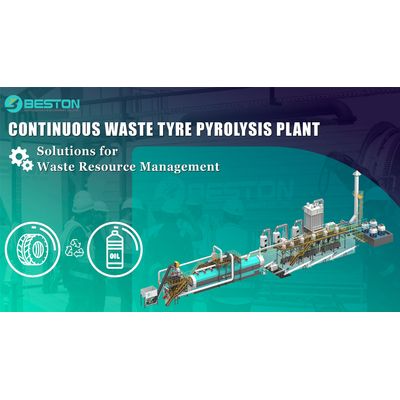

- Home
- Companies
- Beston Group Co., Ltd.
- Articles
- Choosing the Right Tyre Pyrolysis ...

Choosing the Right Tyre Pyrolysis System
Tyre pyrolysis, the process of converting discarded tires into valuable products like fuel oil, carbon black, and steel wire, has gained prominence in recent years as a sustainable solution for waste management. Central to this process are tyre pyrolysis plants, which come in various types and sizes to cater to different needs. In this article, we will explore the diverse world of tyre pyrolysis plants, examining their types and their respective advantages and applications.
Batch Pyrolysis Plant
Description and Operation
Batch pyrolysis plants are designed to process a specific quantity of tyres in a batch, rather than continuously. You can also call this type small pyrolysis machine. The process involves loading a batch of tyres into the reactor, heating them to initiate pyrolysis, and then cooling and discharging the end products once the batch is complete.
Pros and Cons
Batch pyrolysis plants are known for their simplicity and cost-effectiveness. They are suitable for small-scale operations and are relatively easy to maintain. However, their intermittent operation and lower processing capacity can be limitations for larger-scale applications.
Suitable Applications
Batch pyrolysis plants are ideal for businesses or regions with lower tyre disposal volumes, where a continuous operation may not be necessary. They are commonly used in pilot projects, research, and small businesses looking to enter the tyre recycling industry.
Continuous Pyrolysis Plant
Description and Operation
Continuous pyrolysis plants operate continuously, without the need for frequent starts and stops. They feature a conveyor system that feeds tyres into the reactor as needed, allowing for a seamless and uninterrupted process.
Advantages and Limitations
Continuous pyrolysis plants offer higher processing capacities and efficiency compared to batch systems. They are suitable for large-scale tyre recycling operations. However, their initial cost and complexity can be higher, and they may require more substantial infrastructure.
Best Use Cases
Continuous pyrolysis plants are best suited for regions or businesses with substantial tyre waste, such as municipalities or large tyre manufacturers. Their ability to handle high volumes efficiently makes them a preferred choice for industrial-scale tyre pyrolysis.
Semi-Continuous Pyrolysis Plants
Overview of Semi-Continuous Systems
Semi-continuous pyrolysis plants bridge the gap between batch and continuous systems. They can process tyres in batches or with limited interruptions, making them versatile in terms of operation.
Key Features
Semi-continuous plants offer a compromise between simplicity and efficiency. They are suitable for mid-sized tyre recycling operations that require a balance between processing capacity and cost-effectiveness.
Applications and Benefits
Semi-continuous pyrolysis plants are often chosen by businesses looking to expand their tyre recycling capacity gradually. They provide a flexible solution that can adapt to changing demands without the full commitment required for continuous systems.
Small-Scale and Large-Scale Pyrolysis Plants
Small-Scale Tyre Pyrolysis Plants
Small-scale pyrolysis plants are compact and designed for limited processing volumes. They are typically more affordable and require less space and infrastructure.
Large-Scale Tyre Pyrolysis Plants
Large-scale pyrolysis plants are industrial giants capable of processing vast quantities of tyres. They demand a significant initial investment but offer substantial processing capabilities.
Choosing the Right Scale for Your Needs
Selecting the appropriate scale of pyrolysis plant for sale depends on factors like tyre waste volume, available space, and budget. Small-scale plants suit local businesses and small communities, while large-scale plants are preferred for industrial and municipal operations.
In conclusion, tyre pyrolysis plants come in various types and sizes, each catering to specific needs and capacities. Whether you're a small business looking to enter the tyre recycling industry or a large corporation seeking to manage substantial tyre waste, understanding the different types of tyre pyrolysis plants is crucial in making an informed investment decision that aligns with your objectives and resources.
